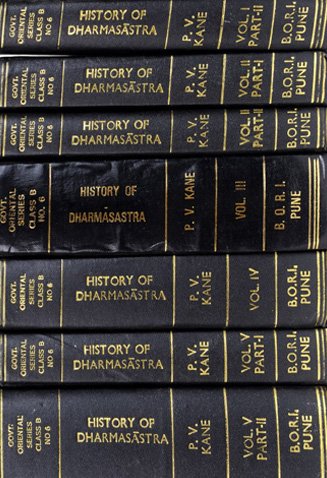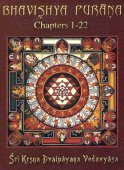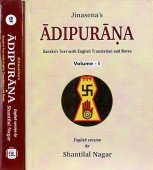Bhavishyapurana, Bhaviṣyapurāṇa, Bhavishya-Purana: 10 definitions
Introduction:
Bhavishyapurana means something in Hinduism, Sanskrit. If you want to know the exact meaning, history, etymology or English translation of this term then check out the descriptions on this page. Add your comment or reference to a book if you want to contribute to this summary article.
The Sanskrit term Bhaviṣyapurāṇa can be transliterated into English as Bhavisyapurana or Bhavishyapurana, using the IAST transliteration scheme (?).
In Hinduism
Purana and Itihasa (epic history)
Source: archive.org: Puranic EncyclopediaBhaviṣyapurāṇa (भविष्यपुराण).—This purāṇa contains the instructions given by the god Sūrya to Manu. There are about fourteen thousand books in this purāṇa and they deal with almost all subjects on earth including such important ones like, Sṛsṭi (creation), Kālamāna (time), Garbhādhāna (conception), Godāna (gift of cows), Āśramadharmas (duties of a hermit) Liṅga Śāstra (science of sex), Viṣacikitsā (treatment of poisoning) and Āyurveda (Medical science). (Chapter 272, Agni Purāṇa).
Source: Cologne Digital Sanskrit Dictionaries: The Purana IndexBhaviṣyapurāṇa (भविष्यपुराण).—(Bhaviṣyam)—one among the mahāpurāṇas; comprises 14,500 ślokas; narrated by Brahmā to Manu containing the māhātmyam of the sun, and the account of Aghora kalpa with the characteristics of Bhūtagrāma; he who makes a gift of it with a kumbha on the Full Moon day of the Puṣya month gets the fruits of the Agniṣṭoma; Lomaharṣaṇa revealed it to the sages.*
- * Bhāgavata-purāṇa XII. 7. 24; 13. 6. Matsya-purāṇa 50. 68, 73-77; 53. 31-33. Vāyu-purāṇa 104. 3; Viṣṇu-purāṇa III. 6. 22.
Bhaviṣyapurāṇa (भविष्यपुराण) refers to one of the eighteen Major Puranas according to the Matsyapurāṇa and other traditional lists of Puranic literature: a category of ancient Sanskrit texts which gives a huge contribution in the development of Indian literature.—The lists of eighteen Mahāpurāṇas (e.g., bhaviṣyapurāṇa) and eighteen Upapurāṇas are not same everywhere, as some names are dropped in some references whereas some are included in others. It can be noticed that, except the Vāyuapurāṇa and the Śivapurāṇa, the names of the Mahāpurāṇas are similar in almost all the Purāṇas.

The Purana (पुराण, purāṇas) refers to Sanskrit literature preserving ancient India’s vast cultural history, including historical legends, religious ceremonies, various arts and sciences. The eighteen mahapuranas total over 400,000 shlokas (metrical couplets) and date to at least several centuries BCE.
Dharmashastra (religious law)
Source: Shodhganga: The saurapurana - a critical study (dharma)Bhaviṣyapurāṇa (भविष्यपुराण) should be donated (dāna) on the day of akṣayatṛtīyā of vaiśākha according to the Dharmaśāstra taught in the 10th century Saurapurāṇa: one of the various Upapurāṇas depicting Śaivism.—Accordingly, the donation of the various Purāṇas to various recipients on different tithis along with the merits thereof are given in the ninth chapter.—[...] Donation of the Bhaviṣyapurāṇa to an Āhitāgni-brāhmaṇa on the day of akṣayatṛtīyā of vaiśākha, with devotion gets the result of aśvamedha sacrifice.

Dharmashastra (धर्मशास्त्र, dharmaśāstra) contains the instructions (shastra) regarding religious conduct of livelihood (dharma), ceremonies, jurisprudence (study of law) and more. It is categorized as smriti, an important and authoritative selection of books dealing with the Hindu lifestyle.
Languages of India and abroad
Sanskrit dictionary
Source: DDSA: The practical Sanskrit-English dictionaryBhaviṣyapurāṇa (भविष्यपुराण).—Name of one of the 18 Purāṇas.
Derivable forms: bhaviṣyapurāṇam (भविष्यपुराणम्).
Bhaviṣyapurāṇa is a Sanskrit compound consisting of the terms bhaviṣya and purāṇa (पुराण).
Source: Cologne Digital Sanskrit Dictionaries: Aufrecht Catalogus Catalogorum1) Bhaviṣyapurāṇa (भविष्यपुराण) as mentioned in Aufrecht’s Catalogus Catalogorum:—Oxf. 30^a. 36^a. L. 1742. 2553. K. 26. B. 2, 18. Ben. 49. Kāṭm. 2. NW. 482. 490. Oudh. Xiii, 36. Np. V, 10. 102. 180. X, 22. Oppert. 1367. 6079 (Kṣetravaibhavakhaṇḍa). Ii, 4787. Rādh. 40 (svalpa). Mentioned in Kūrmapurāṇa Oxf. 8^a, in Vāyupurāṇa Oxf. 59^a, in Mathurāmāhātmya Oxf. 62^b, in Revāmāhātmya Oxf. 65^a, in Devībhāgavatapurāṇa Oxf. 79^b, in Āpastambadharmasūtra 2, 24, 6. Bhaviṣyapurāṇe Anantavratakathā. Paris. (B 98 a).
—Kalirājavarṇana. Kh. 83.
—Kalivyavahāra. W. p. 134.
—Koṭirudrasaṃhitā. Burnell. 203^b.
—Gaṇapatistavarāja. Oxf. 36^a. Burnell. 198^b.
—Gotrirātrikathā. Ben. 56.
—Candraśānti, Maṅgalaśānti, Budhaśānti. W. p. 353.
—Tilakavratakathā. Ben. 56.
—Puruṣottamamāhātmya. Ben. 47.
—Malamāsakathā. Sb. 248.
—Malamāsamāhātmya. Bp. 294.
—Rajotsavamāhātmya. B. 2, 48.
—Vedapādastava. Burnell. 199^a.
—Sārakṣetramāhātmya. Taylor. 1, 440.
—Sūryakavaca. Pet. 723.
Bhaviṣyapurāṇa has the following synonyms: Bhaviṣyatpurāṇa.
2) Bhaviṣyapurāṇa (भविष्यपुराण):—Rgb. 106. Stein 207. Bhaviṣyapurāṇe Gaṇapatistavarāja. Stein 207.
—Sūryasahasranāman. Oudh. Xx, 22.
3) Bhaviṣyapurāṇa (भविष्यपुराण):—Ulwar 810. Bhaviṣyapurāṇe Gaṇeśāṣṭottaraśatanāman. Ulwar 2100.
4) Bhaviṣyapurāṇa (भविष्यपुराण):—As p. 130. Cs 4, 296 (inc.). Io. 1207. 1314. 1429. No. 3448. Tod 2.
—Brāhmaparvan (148 Adhyāyāḥ) and Madhyamatantra (86 Adhyāyāḥ). A peculiar recension of this Purāṇa. See L. 1742 and 2553 A. Bhaviṣyapurāṇe Kaliyugamāhātmya. Bd. 137.
—Kumbhaghoṇamāhātmya from the Madhyamakhaṇḍa. Winternitz Catal. p. 249.
—Pipītakīdvādaśīvrata. Cs 2, 292. Bhaviṣyapurāṇe Rohiṇīvratakathā. Cs 2, 611.
—Somavatyamāvāsyāvrata. L.. 261.
Bhaviṣyapurāṇa (भविष्यपुराण):—[=bhaviṣya-purāṇa] [from bhaviṣya > bhava] n. Name of one of the 18 Purāṇas (the original of which is said to have been a revelation of future events by Brahmā; it is rather a manual of religious rites and observances, [Indian Wisdom, by Sir M. Monier-Williams 512 n. 1])
[Sanskrit to German]
Sanskrit, also spelled संस्कृतम् (saṃskṛtam), is an ancient language of India commonly seen as the grandmother of the Indo-European language family (even English!). Closely allied with Prakrit and Pali, Sanskrit is more exhaustive in both grammar and terms and has the most extensive collection of literature in the world, greatly surpassing its sister-languages Greek and Latin.
Kannada-English dictionary
Source: Alar: Kannada-English corpusBhaviṣyapurāṇa (ಭವಿಷ್ಯಪುರಾಣ):—[noun] = ಭವಿಷ್ಯುತ್ಪುರಾಣ [bhavishyutpurana].
Kannada is a Dravidian language (as opposed to the Indo-European language family) mainly spoken in the southwestern region of India.
See also (Relevant definitions)
Partial matches: Bhavishya, Puraana, Purana.
Full-text (+182): Bhavishyottara, Ganeshastavaraja, Vidud, Bhavishyapuraniya, Dora, Maghava, Gesha, Kurkutivrata, Natankovilsthalamahatmya, Maunjiya, Patteshvaramahatmya, Battishivrata, Pratibhashya, Tithidana, Punyahashabda, Dipotsava, Umamaheshvaravrata, Pathitanga, Mayadarshana, Magasa.
Relevant text
Search found 39 books and stories containing Bhavishyapurana, Bhavishya-puraana, Bhavishya-purana, Bhavisya-purana, Bhaviṣya-purāṇa, Bhaviṣyapurāṇa, Bhavisyapurana; (plurals include: Bhavishyapuranas, puraanas, puranas, purāṇas, Bhaviṣyapurāṇas, Bhavisyapuranas). You can also click to the full overview containing English textual excerpts. Below are direct links for the most relevant articles:
Sanskrit sources of Kerala history (by Suma Parappattoli)
2. Kerala in the Puranas < [Chapter 6 - Miscellaneous Sanskrit works bearing on Kerala history]
Appendix 1 - Sanskrit Works bearing on Kerala History
5.3. Kolanrpotpatti < [Chapter 2 - Historical details from Mahatmyas and Prashastis]
Manusmriti with the Commentary of Medhatithi (by Ganganatha Jha)
Verse 2.135 < [Section XXIV - Degrees of Respect]
Verse 2.183 < [Section XXX - Rules to be observed by the Religious Student]
Verse 2.185 < [Section XXX - Rules to be observed by the Religious Student]
The Vishnu Purana (by Horace Hayman Wilson)
9. The Bhaviṣya Purāṇa < [Preface]
Chapter VIII - Description of the sun (his chariot; its two axles; his horses) < [Book II]
Puranic encyclopaedia (by Vettam Mani)
Animal Kingdom (Tiryak) in Epics (by Saranya P.S)
Rudra-Shiva concept (Study) (by Maumita Bhattacharjee)
42. Number of Rudra < [Chapter 5 - Rudra-Śiva in the Purāṇic Literature]
Related products


